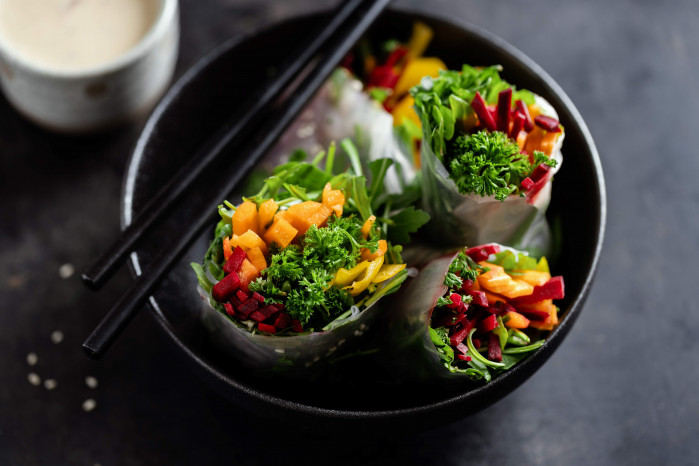News
A Collection Of Restaurant, Food, Drink And Hospitality News From All Over South Africa
Food & Drink Trends for 2024: Capsicum Culinary Studio chefs share their predictions from ‘plushi’ to ‘newstalgia’ to sorghum and a fig leaf ice cream recipe
19 February 2024
According to National Geographic, some of the biggest food trends we can expect to see this year include the use of fig leaves (in everything from ice cream to curries), a rise in the popularity of hot sauces, more creative ways with beans and pulses, posh hash browns, savoury French toast (as opposed to the classic version swimming in maple syrup) and big, meaty mushrooms.
On the drinks front, there’s a move towards consuming low alcohol wines as well as world whiskeys (from New Zealand, Scandinavia, France and Italy), classic gins and modern martinis (anyone fancy a Bilbao martini which contains a drop of anchovy oil?), and the introduction of Pétillant naturel – or pet nat as it is called – a traditionally made semi-sparkling wine that’s bottled while it’s still fermenting.
Meanwhile, restaurants are expecting an increase in large sharing dishes as they entertain patrons with the chef’s playlist of 1980s tunes and live DJs spinning tunes that complement the menu. Also on the increase are restaurant-branded condiments and sauces, as eateries look for additional revenue streams and the best way to use up ingredients that would otherwise go to waste.
On a broader level, the International Food Information Council (IFIC) reports a growth this year in “more functional beverages, a boom in botanicals, rising demand for foods that support emotional well-being, a focus on food labels and a growing acceptance of artificial intelligence (AI).”
Back in South Africa, we asked a few chefs at Capsicum Culinary Studio what they thought would be the big gastronomic trends in this country in 2024 and here’s what they said:
According to Chef Andre van der Merwe (Nelson Mandela Bay campus): “In 2024 we are going to see a huge swing towards more sustainable, green and eco-friendly foods, with nose to tail recipes more commonplace, and an increase in cultural and global fusion foods. Dishes like ‘pap en wors’ will appear on menus but will feature as bite-size snacks, and the humble yet incredible spekboom will become the new culinary foliage or turned into sauces and chutneys. Wedding cakes will be replaced with stacked cheeses adorned with fresh and dried fruits, savoury biscuits, pâtés and dips. Hibiscus will trend again in 2024 - from teas to sugar-coated petals, jams and infusions and the rich aromas of Earl Grey tea will be incorporated into chocolates, sponges and alcohol distillations.”
Chef Charl Botha and his colleagues at the school’s Cape Town campus feel that “grab ‘n’ go meals such as paninis or bagels, fresh salads and even fresh sushi will be consumed more in 2024 due to people’s increasingly busy schedules. Also, with healthy eating on the rise and indications from culinary competitions in 2023, vegan options will increase, and more plant-based products will be consumed than ever before. In this regard, sushi will be traded for ‘plushi’ with ingredients such as salmon replaced by carrot lox and plant-based caviar pearls will substitute for the real thing. The use of gluten-free flours, such as buckwheat, will be used more and more in baked products, there will be healthier variations of caffeine, such as matcha, and chaga mushrooms will make an appearance as consumers strive to get onto the healthy living bandwagon.”
Chef Bongikosi Masengumu who lectures at the school’s Pretoria campus says the big trend for 2024 is sustainable gastronomy. “With an increased focus on environmental consciousness, sustainable food is set to take centre stage this year. As consumers and food handlers, we are becoming more aware of our food choices and, as a result, there will be a greater demand for locally sourced, organic food in environmentally friendly packaging.”
Masengumu’s campus colleague Larozaan van Zyl agrees with her fellow chefs with regards to healthier eating and says: “Vegan desserts will be big as will the dairy-free and gluten-free versions. Consumers are also gravitating towards more stylised, elevated desserts and celebration cakes will become smaller and will eschew over-the-top embellishments for more rustic toppings such as edible flowers, herbs and seasonal berries. Desserts are also shifting shape, with the cube gaining in popularity, and the ever-popular pie popping up as a square.”
Van Zyl also believes that down-home comfort foods will become increasingly popular although they will come with tweaks. “Newstalgia” as she calls it. “Grandma’s recipes are so trendy right now, but they are slightly elevated so expect to see Rice Krispy Treats dressed up with a layer of chocolate, hazelnut chocolate, jam and sprinkles inbetween. Childhood favourites such as chicken pot pie, buttery pound cake and gingersnap cookies are also trending. In fact, pound cake is Southern Living Magazine’s most requested recipe.
She also sees a trend in flavours and flavour mashups. “Cream cheese as a flavour, not an ingredient, is huge. Fig, pomegranate, dulce de leche and watermelon are hot right now. Birthday cake flavour is still popular, and cocktail and alcohol flavours are showing up in baked goods. Trending sweet flavours include blackberry, passion fruit, cotton candy and apple crisp, while on the savoury side, flavours such as dill pickle, hot and spicy, and everything bagel are finding flavour with customers looking for something different. The new flavour profile on the block is ‘swicy’, a sweet and spicy combo. Spicy mango chilli, spicy maple, bourbon jalapeno and chilli powder chocolate chip cookies are just a few flavours pairings that could serve as sources of inspiration for retail bakers looking to differentiate their menus.
“As for flavour mashups, hot honey is popping up on dessert plates and we’re also seeing savoury and sweet come together in different ways, such as basil key lime pie and miso paste chocolate chip cookies.”
Lastly, van Zyl predicts a rise in the use of ancient grains and the trend of ‘Bougie breads.’
“Puratos has a soft ancient grain pre-soaked blend of red quinoa, amaranth, chia, buckwheat, spelt, millet and teff that is enrobed with a fruity rye sourdough and a touch of brown sugar. It brings moisture, texture, and a sourdough flavour to your dough. Speaking of sourdough, when it comes to bread, Bougie breads are also trending. These are made from different coloured doughs that can be laminated and layered with chocolate or strawberry preserve.”
Chef Nandile Mtshaha from Capsicum’s Durban campus says: “Sorghum has been gaining popularity in Africa and I believe as soon as the rest of the world cottons on to this ingredient it will be game over and our forefathers will sing in their graves. The beauty of sorghum is that it is very versatile and can be used to make savoury or sweet dishes. Traditionally, sorghum was used to make Umqhombothi, but today foodies are using it to make baked goods, ice creams and a sour porridge called Ting ya Mabele which can be served with stew. In addition to its versatility, sorghum is also a very cost effective ingredient and affordable for most.”
Durban campus chef lecturer Sharon Visagie predicts a major trend towards sustainable protein replacements such as chickpeas, lentils and pinto beans to name a few. “Consumers are becoming more aware of the negative impacts that cooking meat products has on our health and the health of the environment. This is not necessarily a steering towards veganism but more of a reduction in the intake of meat-based proteins. Superfoods and ancient grains, with their health benefits and incredible flavours, are becoming more and more attractive to consumers. Sustainable cooking, sourcing and consumption has influenced many restaurant patrons and chefs alike.
“Also, acclaimed restaurants around the world are growing and harvesting their own produce, boasting non-GMO and seasonal fruits and vegetables and the shift in sustainable practices can been seen with awards such as the Eat Out Woolworths Sustainability Award which celebrates restaurants that show exceptional dedication to providing sustainable alternatives to the run-of-the-mill restaurant fare. Finally, I think dishes served in restaurants are being presented in a more natural way, celebrating the ingredients used in a more holistic way instead of being overly curated and tweezed to death.”
For anyone wanting to have a go at making Fig Leaf Ice Cream, here’s the recipe:
Ingredients:
- 5 fig leaves fresh or dried
- 250ml whole milk
- 250ml double cream
- 3 egg yolks
- 87g caster sugar
Instructions:
If you're using fresh fig leaves, dry them first. Heat the oven to 100°C fan, place the leaves on a baking tray and heat until the leaves start to curl, and the veins start to turn golden.
Using a heavy-based saucepan, warm the milk and cream together with the fig leaves over a gentle heat until the mixture starts to steam (make sure it doesn't reach boiling point).
In a bowl mix together the sugar and egg yolks. Pour a little of the warm milk and cream mixture onto egg mixture whisking continuously. Continue adding the milk mixture to the egg mixture a little at a time, whisking all the time. Pour the combined mixture back into the saucepan and continue to cook over a low heat until the mixture starts to thicken and coats the back of a spoon, stirring all the time.
Pour this custard mix through a sieve into an air-tight container and freeze for an hour and then mix in a food processor. Freeze for another two hours and mix again. Do this one more time after another two hours and place back in freezer.










